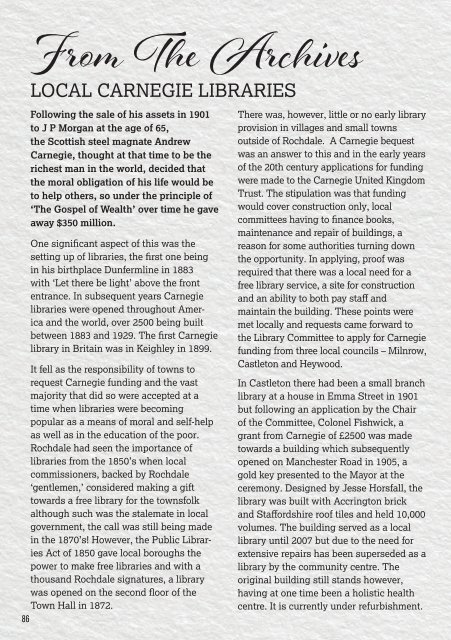Bamford & Norden October 2018
Bamford & Norden October 2018
Bamford & Norden October 2018
Create successful ePaper yourself
Turn your PDF publications into a flip-book with our unique Google optimized e-Paper software.
From The Archives<br />
LOCAL CARNEGIE LIBRARIES<br />
Following the sale of his assets in 1901<br />
to J P Morgan at the age of 65,<br />
the Scottish steel magnate Andrew<br />
Carnegie, thought at that time to be the<br />
richest man in the world, decided that<br />
the moral obligation of his life would be<br />
to help others, so under the principle of<br />
‘The Gospel of Wealth’ over time he gave<br />
away $350 million.<br />
One significant aspect of this was the<br />
setting up of libraries, the first one being<br />
in his birthplace Dunfermline in 1883<br />
with ‘Let there be light’ above the front<br />
entrance. In subsequent years Carnegie<br />
libraries were opened throughout America<br />
and the world, over 2500 being built<br />
between 1883 and 1929. The first Carnegie<br />
library in Britain was in Keighley in 1899.<br />
There was, however, little or no early library<br />
provision in villages and small towns<br />
outside of Rochdale. A Carnegie bequest<br />
was an answer to this and in the early years<br />
of the 20th century applications for funding<br />
were made to the Carnegie United Kingdom<br />
Trust. The stipulation was that funding<br />
would cover construction only, local<br />
committees having to finance books,<br />
maintenance and repair of buildings, a<br />
reason for some authorities turning down<br />
the opportunity. In applying, proof was<br />
required that there was a local need for a<br />
free library service, a site for construction<br />
and an ability to both pay staff and<br />
maintain the building. These points were<br />
met locally and requests came forward to<br />
the Library Committee to apply for Carnegie<br />
funding from three local councils – Milnrow,<br />
Castleton and Heywood.<br />
It fell as the responsibility of towns to<br />
request Carnegie funding and the vast In Castleton there had been a small branch<br />
majority that did so were accepted at a library at a house in Emma Street in 1901<br />
time when libraries were becoming<br />
but following an application by the Chair<br />
popular as a means of moral and self-help of the Committee, Colonel Fishwick, a<br />
as well as in the education of the poor. grant from Carnegie of £2500 was made<br />
Rochdale had seen the importance of towards a building which subsequently<br />
libraries from the 1850’s when local<br />
opened on Manchester Road in 1905, a<br />
commissioners, backed by Rochdale<br />
gold key presented to the Mayor at the<br />
‘gentlemen,’ considered making a gift ceremony. Designed by Jesse Horsfall, the<br />
towards a free library for the townsfolk library was built with Accrington brick<br />
although such was the stalemate in local and Staffordshire roof tiles and held 10,000<br />
government, the call was still being made volumes. The building served as a local<br />
in the 1870’s! However, the Public Libraries<br />
library until 2007 but due to the need for<br />
Act of 1850 gave local boroughs the extensive repairs has been superseded as a<br />
power to make free libraries and with a library by the community centre. The<br />
thousand Rochdale signatures, a library original building still stands however,<br />
was opened on the second floor of the having at one time been a holistic health<br />
Town Hall in 1872.<br />
centre. It is currently under refurbishment.<br />
86<br />
To advertise call 07976 289967 or 07974 434793 or email sales@streetwisemag.co.uk

















